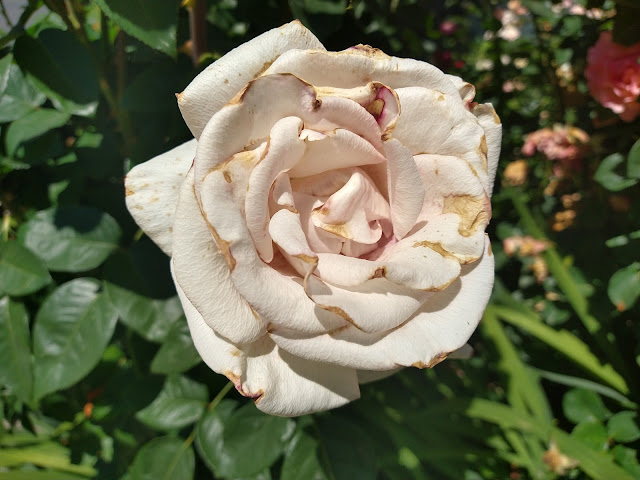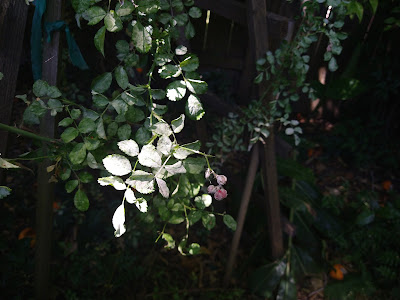

|
| Botrytis freckles and browns the edges of a Pink Promise rose. (Photos: Debbie Arrington) |
May usually is the rosiest month in Sacramento. Warm, dry days coupled with raging growth hormones make for bountiful blooms and healthy plants.
But not this month. Sacramento area rose lovers report problems usually not seen in mid-spring: Botrytis, powdery mildew and blind shoots. All these issues can ruin rose blooms (or eliminate them all together).

|
| Powdery mildew coats foliage on a Dorothy Perkins rambling rose. |
Common in late fall, botrytis attacks buds as they open, turning them to mush. It starts out looking like freckles, then quickly turns petals brown and soft. Roses quite often refuse to fully open.
Powdery mildew is primarily a foliage fungus, covering leaves and stems with what looks like an explosion of powdered sugar. (It can coat buds, too.) Its activated by temperature; days in the 60s or 70s are its sweet spot.
The good news? When days turn 90s degrees, these fungi disappear. They can’t stand high heat. The forecast for this weekend: 92 degrees.
Infected foliage and blooms will fall off and be replaced by healthy growth. Pick up these discards and dispose of them in trash (not compost). That will help cut down on reinfection.

|
| Instead of a bud, there's only a stub on this Marilyn Monroe rose. |
The solution is easy: Cut the blind shoot off. Prune the stem back to just above the first five-leaf leaflet. The bush will soon sprout a new stem, most likely with a bud at the end.
Comments
0 comments have been posted.Sacramento Digs Gardening to your inbox.
Sites We Like
Garden Checklist for week of May 5
Survey your garden after the May 4 rainstorm. Heavy rain and gusty winds can break the neck of large flowers such as roses. Also:
* Keep an eye on new transplants or seedlings; they could take a pounding from the rain.
* Watch out for powdery mildew. Warmth following moist conditions can cause this fungal disease to “bloom,” too. If you see a leaf that looks like it’s dusted with powdered sugar, snip it off.
* After the storm, start setting out tomato transplants, but wait on the peppers and eggplants (they want warmer nights). Pinch off any flowers on new transplants to make them concentrate on establishing roots instead of setting premature fruit.
* Trim dead flowers but not leaves from spring-flowering bulbs such as daffodils and tulips. Those leaves gather energy to create next year's flowers. Also, give the bulbs a fertilizer boost after bloom.
* Pinch chrysanthemums back to 12 inches for fall flowers. Cut old stems to the ground.
* Mulch around plants to conserve moisture and control weeds.
* From seed, plant beans, beets, cantaloupes, carrots, corn, cucumbers, melons, pumpkins, radishes and squash.
* Plant onion sets.
* In the flower garden, plant seeds for asters, cosmos, celosia, marigolds, salvia, sunflowers and zinnias. Transplant petunias, zinnias, geraniums and other summer bloomers.
* Plant perennials and dahlia tubers for summer bloom.
* Don’t wait; plant summer bulbs, such as gladiolus and tuberous begonias.
* Harvest cabbage, lettuce, peas and green onions.